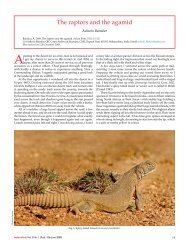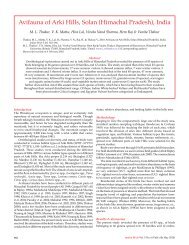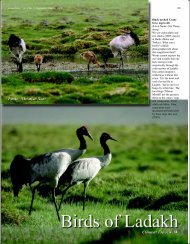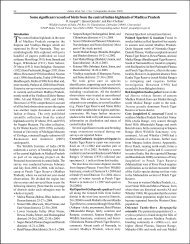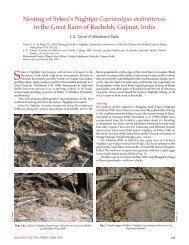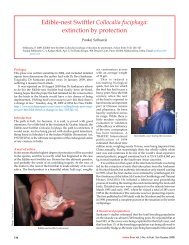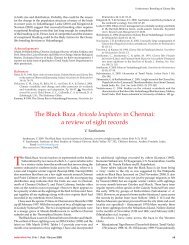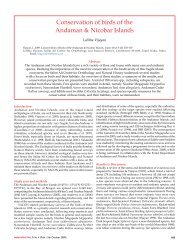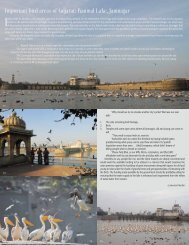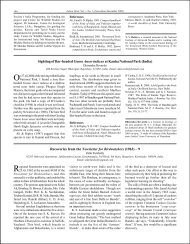A large breeding colony of River Tern Sterna aurantia ... - Indian Birds
A large breeding colony of River Tern Sterna aurantia ... - Indian Birds
A large breeding colony of River Tern Sterna aurantia ... - Indian Birds
Create successful ePaper yourself
Turn your PDF publications into a flip-book with our unique Google optimized e-Paper software.
A <strong>large</strong> <strong>breeding</strong> <strong>colony</strong> <strong>of</strong> <strong>River</strong> <strong>Tern</strong><strong>Sterna</strong> <strong>aurantia</strong> in Chilika Lake, Orissa (India)P. Sathiyaselvam & S. BalachandranSathiyaselvam, P. & Balachandran, S. 2007. Largest nesting <strong>colony</strong> <strong>of</strong> <strong>River</strong> <strong>Tern</strong> <strong>Sterna</strong> <strong>aurantia</strong> in Chilika Lake, Orissa, India. <strong>Indian</strong><strong>Birds</strong> 3 (2): 65–66.P. Sathiyaselvam, Bombay Natural History Society, Hornbill House, Shaheed Bhagat Singh Road, Mumbai 400023, Maharashtra,India. Email: sathiyaselvam11@rediffmail.comS. Balachandran, Bombay Natural History Society, Hornbill House, Shaheed Bhagat Singh Road, Mumbai 400023, Maharashtra,India. Email: bnhsbala@rediffmail.comMss received on 31.viii.2006.<strong>River</strong> <strong>Tern</strong> <strong>Sterna</strong> <strong>aurantia</strong> distribution is restricted totropical Asia—from Iran east through Pakistan, Indiaand Thailand. It inhabits inland river systems, lakesand rarely, estuaries (Ali & Ripley 1983; Harrison 1983).Information on the <strong>breeding</strong> biology <strong>of</strong> the species is limited.During our waterbird population monitoring study atChilika Lake (19º28’–19º54’N 85º05’–85º38’E), Orissa (India),between 2001 and 2005, a <strong>breeding</strong> <strong>colony</strong> <strong>of</strong> three tern speciesnamely Gull-billed Gelochelidon nilotica, Little <strong>Sterna</strong> albifronsand <strong>River</strong> terns was recorded on Nalabana Island (19º42’36"N85º28’48"E) located in Chilika Lake. We recorded nestingseason, nest locations, nest materials, clutch size and threats tothe <strong>breeding</strong> terns for three consecutive years (2002, 2003 &2004). Nests were marked with 5 cm long, well-camouflagedsign strips, to avoid repeated counting and to confirm the clutchsize and incubation period. The sign strips were numbered toidentify individual nests and nest locations were marked witha Global Positioning System (GPS). To minimize disturbance tothe nesting / brooding birds, surveys were mostly done earlymorning and late evening. Care was taken to minimize thedisturbance while moving into the <strong>colony</strong> site.In Chilika especially at Nalabana Island, the <strong>River</strong> <strong>Tern</strong>population began to build up from February, as birds arrivedto the Island for <strong>breeding</strong>, and peaked in April (Fig. 1). Thoughterritory marking and mobbing behaviour occurred in lateFebruary in all the <strong>breeding</strong> seasons, nest construction andegg laying were recorded only in the last week <strong>of</strong> March. Ourdata <strong>of</strong> the <strong>River</strong> <strong>Tern</strong>’s main nesting season (from the end <strong>of</strong>March to June), clutch size, and incubation period,corroborates that <strong>of</strong> Ali & Ripley (1983). From studies in GujaratClement Francis<strong>River</strong> <strong>Tern</strong> <strong>Sterna</strong> <strong>aurantia</strong><strong>Indian</strong> <strong>Birds</strong> Vol. 3 No. 2 (March–April 2007)65
Sathiyaselvam & Balachandran. <strong>River</strong> <strong>Tern</strong> <strong>Sterna</strong> <strong>aurantia</strong> in Chilika Lakeit appears that the <strong>breeding</strong> season is closely linked to theappearance <strong>of</strong> safe nesting substrate, mainly islands and inyears when water levels are such that safe islands emerge inNovember, the <strong>breeding</strong> season can commence early andsecond clutches are also laid (Mundkur 1991).In all the three <strong>breeding</strong> seasons, the shallow, unlined nestswere observed on dry, open, sandy, and invariably, slightlyelevated ground. The average size <strong>of</strong> newly constructed nestswas 18.6cm (±1.8cm) in diameter and 7.3cm (±0.9cm) in depth(n=44). Dead gastropods, shells and tern feathers were usedas nesting materials in some nests. Though clutch size variedbetween years, most <strong>of</strong> the nests were found with two to threeFig 1. Population fluctuation <strong>of</strong> <strong>River</strong> <strong>Tern</strong>in Nalabana Islandeggs. One nest each with four and five eggs was seen in 2002and 2003 respectively. Food in nests, either dropped by adultsor regurgitated by hatchlings, was collected for identification—to ascertain the diet <strong>of</strong> <strong>breeding</strong> terns. Three genera / species<strong>of</strong> brackish water fishes namely, Aterinomorus duodecimalis,Nandus nandus and Mugil sp., were fed to the chicks.Though Neelakantan (1988) and Saxena (1992) state thatthe <strong>River</strong> <strong>Tern</strong> breeds sporadically throughout India, only asmall number <strong>of</strong> nests have been recorded in each <strong>colony</strong>,colonies numbering many hundred nests were recorded byBaker (1929). Larger <strong>River</strong> <strong>Tern</strong> colonies have been recordednear Pune (Bharucha et al. 1988; E. Bharucha verbally) and inPong Dam (D. S. Dhadwal verbally; S. Balachandran fieldobservation). However, Mundkur (1991) estimated a total <strong>of</strong>456 nests during an entire nesting season, including renestingpairs, in a freshwater riverbed near Rajkot city, Gujarat.The 540-nest <strong>colony</strong> <strong>of</strong> Nalabana Island, during 2002, isprobably the <strong>large</strong>st known <strong>breeding</strong> <strong>colony</strong> for this species.Moreover, occurrence <strong>of</strong> such a <strong>large</strong> <strong>colony</strong> on an island in abrackish lake is noteworthy, especially since <strong>large</strong> colonies <strong>of</strong>this freshwater preferring tern were hitherto recorded eitheralong the riverbeds or islands or on margins <strong>of</strong> freshwaterdams. The terns are most probably constrained to use a salineenvironment due to the disturbance around freshwaterhabitats that prevents their nesting. It is worth mentioninghere that this species rarely occurs in estuaries, contrary toAli & Ripley (1983). Most <strong>of</strong> the colonies described fromnorthern India were either on sand pits, sand banks or isletsin perennial rivers (Baker 1935; Ali & Ripley 1983).Table 1. Total nests <strong>of</strong> <strong>River</strong> <strong>Tern</strong> on Nalabana IslandYearNumber <strong>of</strong> nests2002 5402003 4762004 304Despite the availability <strong>of</strong> several riverbeds within a radius<strong>of</strong> 50 km <strong>of</strong> Nalabana, the preference for this island for nestingmay be due to its being uninhabited and a sanctuary protectedfrom human interference, although as explained further cattlegrazing by villagers indicates a level <strong>of</strong> human disturbance.Though Hussain et al. (1984), Mohapatra (1998) and Acharya& Kar (2000) reported <strong>breeding</strong> colonies <strong>of</strong> Gull-billedGelochelidon nilotica and Little S. albifrons <strong>Tern</strong>s on NalabanaIsland, <strong>breeding</strong> colonies <strong>of</strong> <strong>River</strong> <strong>Tern</strong> were not recorded earlier.However, during our study, <strong>River</strong> <strong>Tern</strong> was the predominanttern species in all the seasons. This suggests that the <strong>large</strong> <strong>River</strong><strong>Tern</strong> <strong>colony</strong> on Nalabana has been established recently.Floods are the single greatest threat to the <strong>colony</strong> at Nalabana.In all the three seasons, the hatching success here was above70% but the fledging success was less than 5%. Nalabana beginsto submerge in the rising waters <strong>of</strong> Chilika from the secondweek <strong>of</strong> May, and remains under water till early November.The flooding <strong>of</strong> the Island is caused by the incursion <strong>of</strong> seawaterdue to strong winds in summer, and subsequently by rainwaterduring monsoon. As this flooding coincides with the terns’peak <strong>breeding</strong> season, the un-hatched eggs and chicks arewashed away.Grazing domestic buffaloes from nearby villages causedadditional damage to the <strong>breeding</strong> birds, as well as nests. Theytrampled altogether 59 nests during the three years. 44 nestsbeing destroyed in 2003 alone. Egg predation by bandicootsBandicota sp. was another threat to the <strong>breeding</strong> birds and atotal <strong>of</strong> 99 eggs were found in their tunnels during 2002 and2003, several <strong>of</strong> which were <strong>of</strong> the <strong>River</strong> <strong>Tern</strong>. Mundkur (1991)also reported predation by bandicoot in colonies around Rajkot.ReferencesAcharya, S. 2000. Nesting studies in Nalabana Island, Chilika Lagoon,Orissa. Newsletter for Birdwatchers 40 (6): 79.Ali, S. & Ripley, S. D. 1983. Handbook <strong>of</strong> the birds <strong>of</strong> India and Pakistan.Compact edition, New Delhi: Oxford University Press.Baker, E. C. S. 1929. The fauna <strong>of</strong> British India, including Ceylon and Burma.<strong>Birds</strong>. 2 nd ed. London: Taylor & Francis.Baker, E. C. S. 1935. Nidification <strong>of</strong> <strong>Birds</strong> <strong>of</strong> the <strong>Indian</strong> Empire. Vol. IV.London: Taylor and Francis.Bharucha, E. K., Gogte, P. P. & Gole, T. P. 1988. A new nesting <strong>colony</strong> <strong>of</strong><strong>River</strong> <strong>Tern</strong>s and Pratincoles. J. Bombay Nat. Hist. Soc. 85 (1): 191–193.Harrison, P. 1983. Seabirds: an identification guide. Kent, England: CroomHelm Ltd.Hussain, S. A., Mohapatra, K. K. & Ali, S. 1984. Avifaunal pr<strong>of</strong>ile <strong>of</strong>Chilika Lake: A case for conservation. Bombay Natural HistorySociety. Technical Report 4.Mohapatra, K. K. 1998. Food and feeding habits <strong>of</strong> important aquaticbirds <strong>of</strong> Chilika Lake, Orissa. Final report. Mumbai: Bombay NaturalHistory Society.Mundkur, T. 1991. Nesting and feeding ecology <strong>of</strong> aquatic birds in Saurashtraand Gulf <strong>of</strong> Kachchh. Unpublished Ph.D. thesis. Saurashtra University,Rajkot, India.Neelakantan, K.K. 1990. Breeding <strong>of</strong> the <strong>River</strong> <strong>Tern</strong> <strong>Sterna</strong> <strong>aurantia</strong> inKerala. J. Bombay Nat. Hist. Soc. 87 (1): 144145.Saxena, R. 1992 <strong>River</strong> <strong>Tern</strong> <strong>Sterna</strong> <strong>aurantia</strong> Gray snatching a fish fromPariah Kite Milvus migrans (Boddaert) in flight. J. Bombay Nat. Hist.Soc. 88 (3):66 <strong>Indian</strong> <strong>Birds</strong> Vol. 3 No. 2 (March–April 2007)



